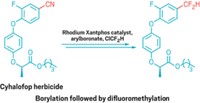Advertisement
Grab your lab coat. Let's get started
Welcome!
Welcome!
Create an account below to get 6 C&EN articles per month, receive newsletters and more - all free.
It seems this is your first time logging in online. Please enter the following information to continue.
As an ACS member you automatically get access to this site. All we need is few more details to create your reading experience.
Not you? Sign in with a different account.
Not you? Sign in with a different account.
ERROR 1
ERROR 1
ERROR 2
ERROR 2
ERROR 2
ERROR 2
ERROR 2
Password and Confirm password must match.
If you have an ACS member number, please enter it here so we can link this account to your membership. (optional)
ERROR 2
ACS values your privacy. By submitting your information, you are gaining access to C&EN and subscribing to our weekly newsletter. We use the information you provide to make your reading experience better, and we will never sell your data to third party members.
Catalysis
Nitrous oxide harnessed for phenol synthesis
Nickel catalyst helps greenhouse gas prove its worth as a chemical reagent
by Mark Peplow, special to C&EN
April 28, 2022
| A version of this story appeared in
Volume 100, Issue 15

Nitrous oxide (N2O) may be known as laughing gas, but it has an unhappy climate impact. This potent greenhouse gas, released by sectors that include agriculture and the chemical industry, makes up about 7% of US greenhouse gas emissions. Harnessing it as a chemical feedstock could reduce N2O’s climate impact, but it’s generally thought to be a pretty inert molecule and has seen little use as a reagent.
That attitude could begin to change, thanks to a nickel catalyst that uses N2O to convert aryl halides into a wide variety of phenols (Nature 2022, DOI: 10.1038/s41586-022-04516-4). Although there are other ways to make phenols from aryl halides, this reaction could be an attractive alternative because of its practical ease, says Josep Cornella at the Max Planck Institute for Kohlenforschung, who led the work. “It happens at mild conditions with a cheap nickel catalyst, and it generates nitrogen as a by-product,” he says.
The nickel catalyst, bound to a pyrazolyl bipyridine ligand, helps replace the aryl substrate’s halide atom—iodine or bromine—with the oxygen atom from N2O. The reaction runs at 25 °C with N2O at a pressure of just 150–200 kPa. It successfully turned dozens of aryl halides into phenols without damaging a variety of other functional groups in the molecules. For example, N2O reacted with a brominated derivative of ezetimibe, a cholesterol-lowering medication, without altering its unprotected chiral alcohol, ester, or strained β-lactam ring (shown).
“N2O is sort of the ignored greenhouse gas,” says Lawrence R. Sita at the University of Maryland, College Park, who also uses N2O as a reagent and was not involved in the new research. “Oxo transfer from N2O has been done before, but not to make new organic molecules through catalytic C–O single-bond formation. It’s beautiful work.”
Using greenhouse gases as feedstock could provide an economic incentive to capture these emissions from industrial processes. Although over half of human-generated N2O emissions come from agriculture, making them tough to capture, fossil fuel burning and the chemical industry combine to make up about 13% of global N2O emissions (Nature 2020, DOI: 10.1038/s41586-020-2780-0). Chemical plants that make nitric acid or adipic acid collectively emit hundreds of thousands of metric tons of N2O per year.
Cornella acknowledges that the new reaction is not about to solve the problem of N2O emissions. But by proving that N2O can serve as an oxygen source in organic synthesis, he hopes it could inspire progress to make better use of this problematic greenhouse gas. Cornella’s team is now developing the reaction to make chiral alcohols and other functional groups containing C–O bonds.





Join the conversation
Contact the reporter
Submit a Letter to the Editor for publication
Engage with us on Twitter